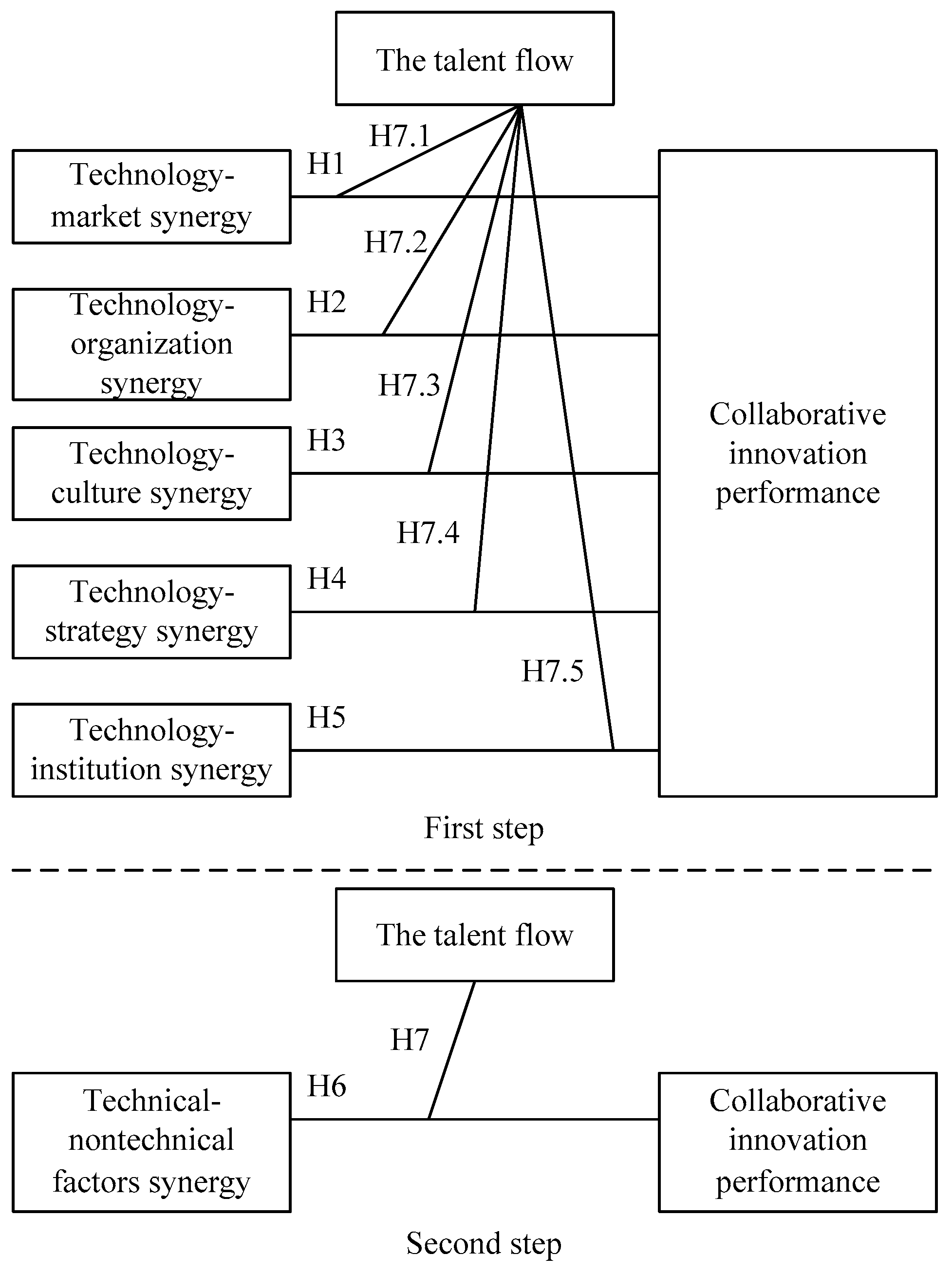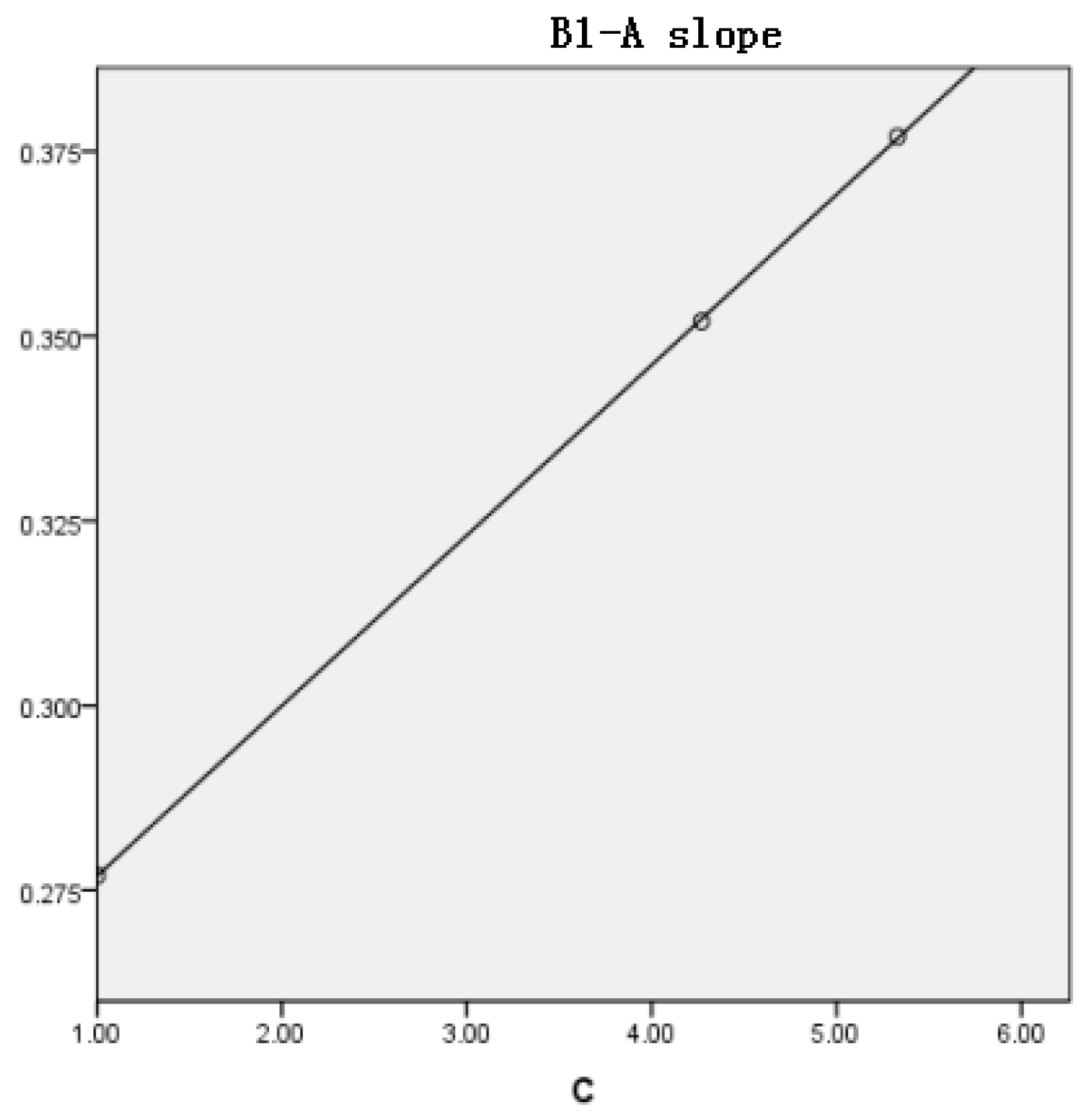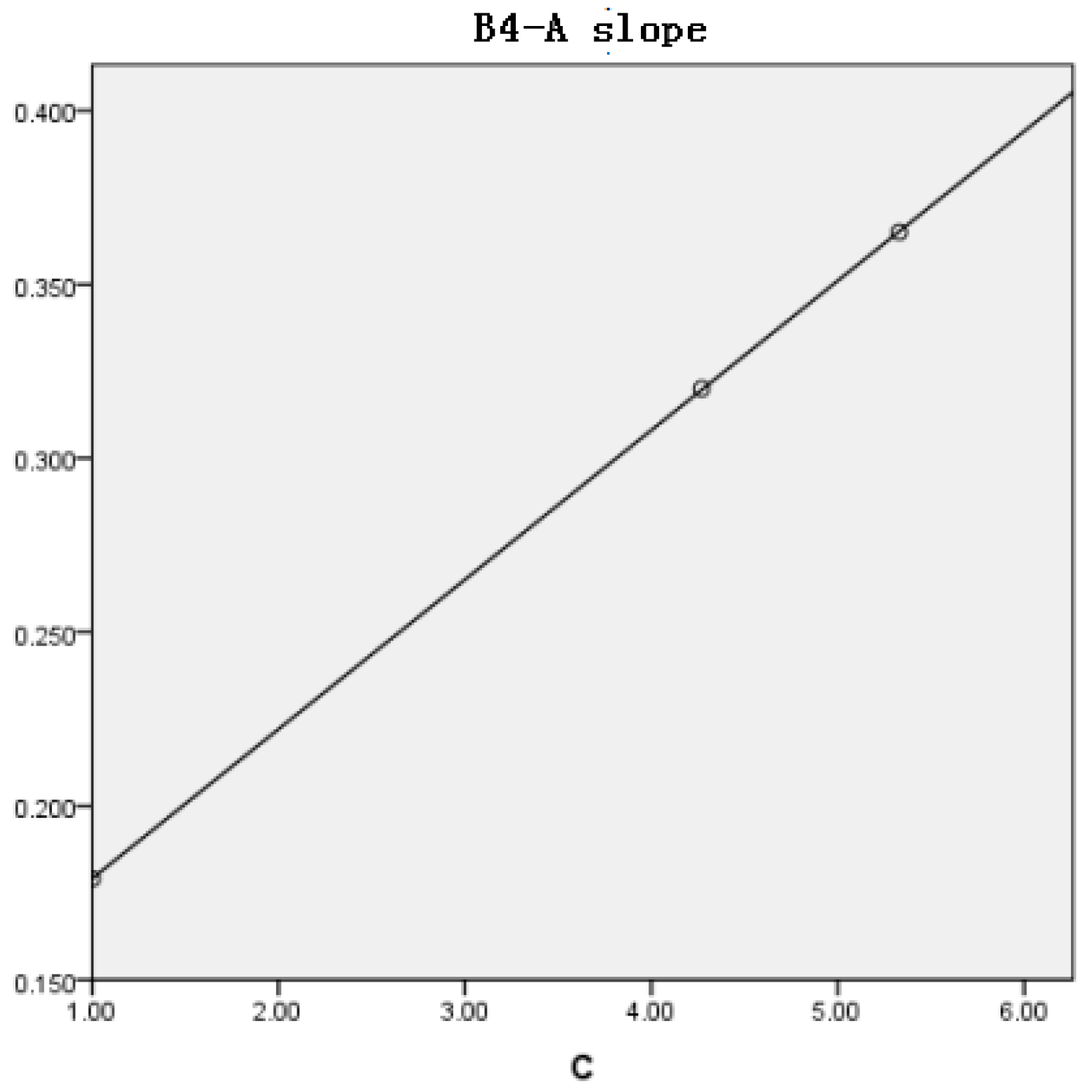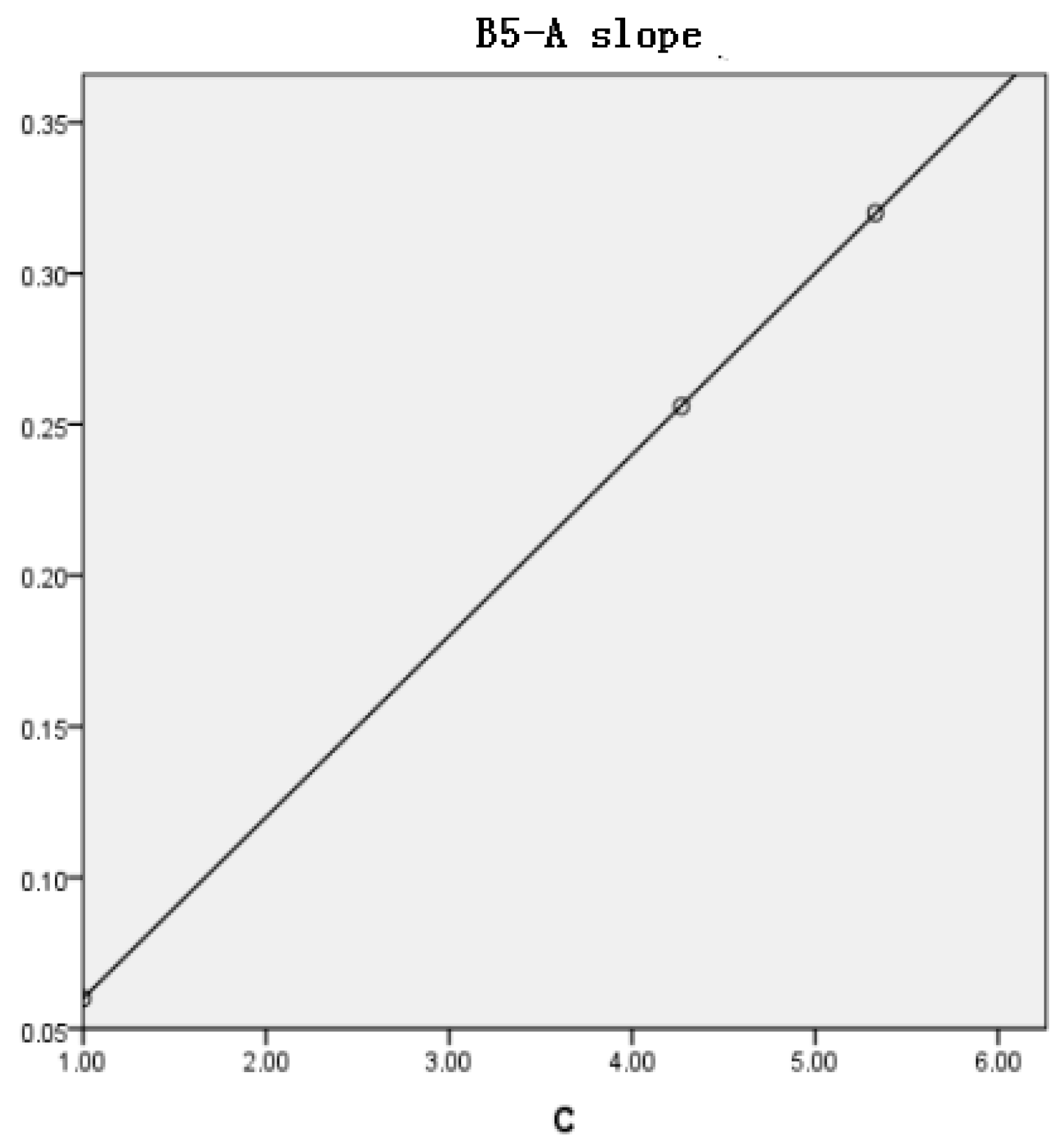1. Introduction
Since the beginning of the twenty-first century, the high profit and low threshold of the internet industry are attracting a large number of enterprises and entrepreneurs to enter this industry. This phenomenon leads to a shorter product life cycle, serious homogenization, increasingly fierce competition and other issues. Enterprises that want to survive in the competition must enhance innovation ability. The enterprise innovation is a systematic process, and unilateral innovation of technology is far from enough. It is necessary to cover the internal innovation network, including organization, strategy, culture, market, system and other elements of the synergy.
In the process of enterprise innovation, an internet company can coordinately use technology, market, organization, culture, strategy, system and other elements to enhance the sustainability of its collaborative innovation ability [
1]. A large number of studies have shown that technical factors and nontechnical factors (market, organization, culture, etc.) are not synergistic in the practical process of innovation. This is an important reason for the failure of many product technology innovation projects [
2,
3]. Zheng Gang and Zhu Ling analyzed the relationship between comprehensive synergy and company innovation performance based on the five-stage model and synergy theory. They found that comprehensive element synergy can enhance innovation performance when experiencing the five stages, such as communication, competition, cooperation, integration and synergy [
1]. Organization structure is an important factor that influences company innovation performance. Adarves-Yomo, Postnes and Haslam studied group member innovation behavior from a corporation organization perspective and found that organization and group norms have an important impact on group innovation performance [
4]. Brettel and Cleven studied the influence of corporation culture and collaboration with external partners on new product development performance. It was found that culture has a direct impact on new product development [
5]. Hadjinanolis conducted an empirical study on small and medium manufacturing corporations to study the antecedents of innovation [
6]. He concluded that institution, strategy, culture and organization can influence corporation innovation performance. Additionally, corporation elements synergy is also studied by some researchers, who indicated that elements synergy will influence innovation performance [
7,
8,
9]. From a corporation performance management perspective, Lian Zhimei also indicated that culture, strategy, organization and management control influence innovation performance [
10]. Of course, there are many other elements that also influence corporation innovation performance such as enterprise network, enterprise knowledge and social capital [
11].
Based on previous research on the factors that influence enterprise innovation, we can conclude that enterprise innovation is related to market, organization, culture and strategy. The synergy between technology and production element is very important for enterprise innovation performance.
On the other hand, the rapid development of the internet industry not only brings fierce competition; it also results in talent shortage. Highly frequent talent flow is another major problem that internet companies face. Talent flow refers to the inflow and outflow of talents in a company. It hints at the instability of talent. Highly frequent talent flow of an enterprise means that many new employees enter the company and many old employees leave as well.
Based on the transformation efficiency of tacit knowledge, Sun Jinhua found that there was a positive correlation between the appropriate talent flow rate and collaborative innovation performance [
12]. The Katz curve also showed that companies with a talent flow rate of less than five percent did not have the ability to innovate. However, the highly frequent talent flow also has an adverse impact on enterprise innovation. For example, Pan Jing pointed out that highly frequent talent flow would have a negative impact on the enterprise’s innovation ability, and reduce the enterprise’s innovation performance [
13].
Therefore, both the talent flow and technical–nontechnical factors synergy are considered in this paper. We want to further research the cross effect of talent flow and technical–nontechnical factor synergy on enterprise innovation performance. Concretely, we choose internet enterprises as a sample with which to study whether there is a correlation between technical–nontechnical factors synergy and collaborative innovation performance, and whether the talent flow has a moderating effect on this relationship. Although this paper focuses on internet companies, it is also valuable for other industries or research areas, such as sustainable high-technology industries. Based on our results, we provide the corresponding countermeasures and suggestions to improve the internet enterprises’ innovation ability through factor cooperation.
3. Empirical Analysis
3.1. Descriptive Statistics
3.1.1. Sample Sector Distribution
The 155 valid questionnaires come from all the departments needed for the study, namely, the Integrated Management Department (Human resources, Administration, Strategy, and Finance), Marketing Department and R&D Department. The Recycling Questionnaire covers all the elements of this study—technology, market, organization, culture, strategy and system—which lay a solid foundation for researching the relationship between internal factor collaboration and innovation performance. The specific distribution is shown in
Table 2.
3.1.2. Sample Age and Academic Distribution
From
Table 3, we can see that the age of the internet industry practitioners is generally relatively small, basically under 35 years old; employees have a higher education, basic education for undergraduate or master; such employees pay more attention to the realization of their own value and they are more likely to quit, which is the reason for the high turnover rate of talent.
3.1.3. Variable Descriptive Statistics
The measurement of eight variables and the description of the statistics are shown in
Table 4.
Table 4 shows that the score of the enterprise internal factors synergy is more than four points and the score of the talent flow is five points or more. This indicates that the internet business collaboration innovation is good and the talent flow is frequent.
3.2. Reliability and Validity Test
Cronbach’s alpha value is often used to evaluate the reliability of latent variables. The threshold of Cronbach’s alpha value is 0.6. From
Table 5, we can see that Cronbach’s alpha value of each variable is more than 0.65, which indicates that the reliability of each variable is high and the data consistency is good. We evaluated the validity of latent variables by adopting factor analysis. The results are showed in
Table 5. The KMO (Kaiser-Meyer-Olkin) values of the variables are all greater than 0.6, the Bartlett significance probability is 0.000 (
p-value), and the cumulative variance explanatory rate was more than 60%, indicating that the questionnaire is effective enough to measure variables. For survey method, it is necessary to check common method bias. We use Harmon single factor analysis to evaluate whether there is a common method bias problem with our data. The result shows that common method factor does not influence latent variable measure item. So, we conclude that there is not a common method bias problem with the data.
3.3. Hypothesis Test
After judging the data validity and reliability, this paper starts to verify the hypothesis. In order to test the relationship between technical–nontechnical element synergy and collaborative innovation performance, the paper takes collaborative innovation performance as the dependent variable and technical–nontechnical element synergy as independent variables to carry out the correlation analysis. As can be seen from
Table 6, there is a significant positive correlation between technical–nontechnical element synergy and collaborative innovation performance, the significance level is 0, concluding that H1, H2, H3, H4, H5 and H6 were supported. In addition, it is found that the synergistic effect of comprehensive coordination of technical–nontechnical elements is more positive than that of the synergies of two of technical–nontechnical elements, which means that the interaction of the elements produces the overall effect that the single factor cannot achieve, and achieves “1 + 1 > 2” advantage.
3.4. Regulation Test
Based on the previous verification of the basic hypothesis, this paper further verifies the moderating effect of the talent flow. The paper uses the method of hierarchical regression to verify the moderating effect of the talent flow on the correlation between technical–nontechnical element synergy and collaborative innovation performance. In order to verify the moderating effect, we firstly calculated the regression relationship between independent variable and dependent variable. Then, by calculating the regression relationship between cross-value and dependent variable, we verified whether the moderating effect was significant.
3.4.1. Technical–Nontechnical Element Comprehensive Synergy and Talent Flow
ΔR
2 and the coefficients were used to evaluate the efficiency of regression. It can be seen from
Table 7 that the three equations of ΔR
2 and the coefficients of B0*C are significant, which indicates that the regulation effect exists. Furthermore, we judged the moderating direction by drawing the moderating regression figure.
Figure 2 shows regression result. The abscissa represents the value of the moderating variable and the ordinate represents the correlation coefficient between independent variable and dependent variable. According to
Figure 2, we can see that the greater the C is, the greater the correlation coefficient is. This means the moderating variable positively moderates the relationship between technical–nontechnical element comprehensive synergy and collaborative innovation performance. This supports H7.
3.4.2. Technical–Market Element Synergy and Talent Flow
Table 8 shows the results of moderating analysis between technical–market element synergy and collaborative innovation performance. With
Table 8, we can see that the three equations of ΔR
2 and the coefficients of B1*C are significant, which indicates that the regulation effect exists. It can be seen from
Figure 3 that the greater the C is, the greater the effect of B1 on A is, which supports H7.1—the talent flow has a positive regulation effect on the correlation between technical–market element synergy and collaborative innovation performance.
3.4.3. Technical–Organizational Element Synergy and Talent Flow
Table 9 shows the results of moderating analysis between technical–organizational element synergy and collaborative innovation performance. According to
Table 9, we can see that the three equations of ΔR
2 and the coefficients of B2*C are not significant, which indicates that there is no moderating effect on the correlation between the synergy between technical–organizational element synergy and collaborative innovation performance and assumes that H7.2 is not established.
3.4.4. Technical–Cultural Element Synergy and Talent Flow
Table 10 shows the results of moderating analysis between technical–cultural element synergy and collaborative innovation performance. According to
Table 10, we can see that the three equations of ΔR
2 and the coefficients of B3*C are not significant, which indicates that there is no moderating effect on the correlation between the synergy between technical–cultural element synergy and collaborative innovation performance and assumes that H7.3 is not established.
3.4.5. Technical–Strategic Element Synergy and Talent Flow
Table 11 shows the results of moderating analysis between technical–strategic element synergy and collaborative innovation performance. According to
Table 11, we can see that the three equations of ΔR
2 and the coefficients of B4*C are significant, which indicates that the regulation effect exists. It can be seen from
Figure 4 that the greater the C is, the greater the effect of B4 on A is, which supports H7.4—the talent flow has a positive regulation effect on the correlation between technical–strategic element synergy and collaborative innovation performance.
3.4.6. Technical–Institutional Element Synergy and Talent Flow
Table 12 shows the results of moderating analysis between technical–institutional element synergy and collaborative innovation performance. According to
Table 11, we can see that the three equations of ΔR
2 and the coefficients of B5*C are significant, which indicates that the regulation effect exists.
Figure 5 shows that the greater the C is, the greater the effect of B5 on A is, which supports H7.5—the talent flow has a positive regulation effect on the correlation between technical–institutional element synergy and collaborative innovation performance.
3.5. Results Discussion
Based on the above analysis, it can be concluded that H1, H2, H3, H4, H5, H6 are supported. In the internet enterprise, the technology–nontechnical factors synergy are beneficial to the improvement of the collaborative innovation performance, and the comprehensive coordination of the elements can generate integration advantages that single factor synergy cannot produce.
According to
Table 6, all of the Pearson correlations are greater than 0.4. This means all technical–nontechnical element synergy is related to corporate innovation performance. For example, the Pearson correlation for technical–market synergy is 0.599 and
p value is less than 0.001. When a company makes synergy between technology and market, it will have a better innovation performance. This result is similar to previous research and discussion. With these results, companies that want to improve corporate innovation performance should establish the synergy between technical element and nontechnical element. Especially, the Pearson correlation for comprehensive technical–nontechnical element synergy is 0.706 and
p value is less than 0.001. This result demonstrates that comprehensive synergy also has a close relation with corporate innovation performance. So, for every company, it is better to accomplish comprehensive synergy. Comprehensive synergy is beneficial to help company to obtain a greater advantage.
As for the moderating effect of talent flow, we establish the hypotheses: H7, H7.1, H7.2, H7.3, H7.4, H7.5. According above moderating test result, we can conclude that H7, H7.1, H7.4, H7.5 are established and H7.2, H7.3 are not established. This shows that the talent flow can positively moderate technical–market element synergy, technical–institutional element synergy, technical–strategic element cooperation, technical–nontechnical element synergy to collaborative innovation performance. Market demand changes fast. The synergy between technology and market is beneficial to help companies to make fast responses to market demand change. Talent flow influences this relationship. Company institutions are established by employees and are also manages their behavior. Talent flow will influence institution operation effectiveness, and influence finally corporate innovation performance. Company strategy generally includes talent strategy. So, talent flow that is too high will influence the strategy accomplishment effectiveness. Talent is the most important resource for a company; talent flow moderates the relation between comprehensive synergy and innovation performance.
However, there is no moderating effect on the correlation of technical–organizational element synergy, technical–culture element synergy and collaborative innovation performance. In order to adapt to the rapid development of the environment, the organizational structure of the internet is flat and the level is less. This organization structure can adapt to the high-speed talent flow, and the company’s corporate culture in the early days of the enterprise has been finalized, unless there is a major change. So the flow of talent cannot adjust the two groups’ relationship. As for company culture, employee’s decisions of leaving or entering a company are greatly related to the company’s culture. In other words, talent flow is one part of company culture. So, talent flow may not moderate the relation between technical–culture synergy and corporate innovation performance.
4. Research Conclusions
This article explores the correlation relationship between technical–nontechnical element synergy and collaborative innovation performance and whether the talent flow frequency has a moderating effect on the relationship in the context of the internet industry. It mainly uses the method of correlation analysis and hierarchical analysis. After analysis, the following conclusions can be obtained:
The synergy of the internal factors of the internet company can enhance the performance of enterprise collaborative innovation performance. Additionally, the synergy of the overall factors can produce an integration advantage that cannot be produced by single factor synergy. Therefore, in the process of strengthening innovation, enterprises should not only improve the technical factors, such as the proportion of R&D investment, the standardization of scientific research equipment, but also should pay attention to the nontechnical factors in innovation network, strive to achieve technical–nontechnical elements synergy and build collaborative innovation networks.
The talent flow has a positive moderating effect on the correlation relationship between technical–nontechnical element synergy and collaborative innovation performance. Therefore, internet companies can moderate the flow of talent to adjust the relationship between internal factors synergy and innovation performance, and then improve the performance of enterprise innovation. However, it should be noted that the high rate of talent turnover should be caused by new staff and internal staff team cooperation, rather than by employees leaving. So, internet companies need to control the turnover rate. At the same time, they should strengthen the internal flow frequency to enhance the internal staff vitality and passion, stimulate their innovative thinking and finally enhance corporate innovation performance.
Considering the fact that innovation and talent drive sustainable development, any company should pay more attention to innovation performance and talent reservation. In other word, sustainability cannot be separated from technology innovation and talent. So, the results have valuable references for any sustainability, such as environment, society, economic and so on.
The research of this paper has great theoretical and practical significance. On the one hand, this paper broadens the research scope of collaborative innovation theory. It specially focuses on the effect of talent flow on the relationship between element synergy and innovation performance. This provides new research perspectives, inspiring future research to pay more attention to talent flow. On the other hand, the results offer practical suggestions for members of this area. Internet companies should try to enhance corporate element synergy including technical–nontechnical synergy, which is positively related to innovation performance. At the same time, although proper talent flow is beneficial for company to get external knowledge and open innovation, more frequent talent flow will influence the positive effect of synergy on innovation performance. So, every internet company should pay more attention to their talent flow problem.
Of course there are some limitations in our paper. The data used in model analysis are surveyed from internet companies. So, the results may not be directly applicable for other industry with special characteristics. At the same time, it is better to use long term and continuous data to analyze the effect of synergy on innovation performance. We will try our best to improve the research in future.










